MGT603 Systems Thinking Report: Red Bubble Company Analysis
VerifiedAdded on 2022/09/14
|9
|1841
|10
Report
AI Summary
This report provides a comprehensive analysis of Red Bubble Company using systems thinking methodologies. It begins with a Rich Picture illustrating the company's operational complexities and challenges, particularly concerning inventory management. The report then employs CATWOE analysis to identify key stakeholders, their perspectives, and the transformation processes within Red Bubble. This includes an examination of customers, actors (managers and employees), the transformation process (from order placement to delivery), worldview (customer expectations), owners, and the environmental factors impacting the company. The report highlights the need for improved inventory control and the potential benefits of implementing an ERP system, incorporating machine learning to analyze customer purchase trends. The recommendations focus on implementing an ERP system to improve inventory management and incorporating machine learning algorithms to understand customer preferences, leading to better business outcomes. The report is a response to an assessment brief requiring analysis of a company's problem using systems thinking tools and techniques, including a Rich Picture and CATWOE analysis, to identify solutions and make recommendations for optimal decision-making.
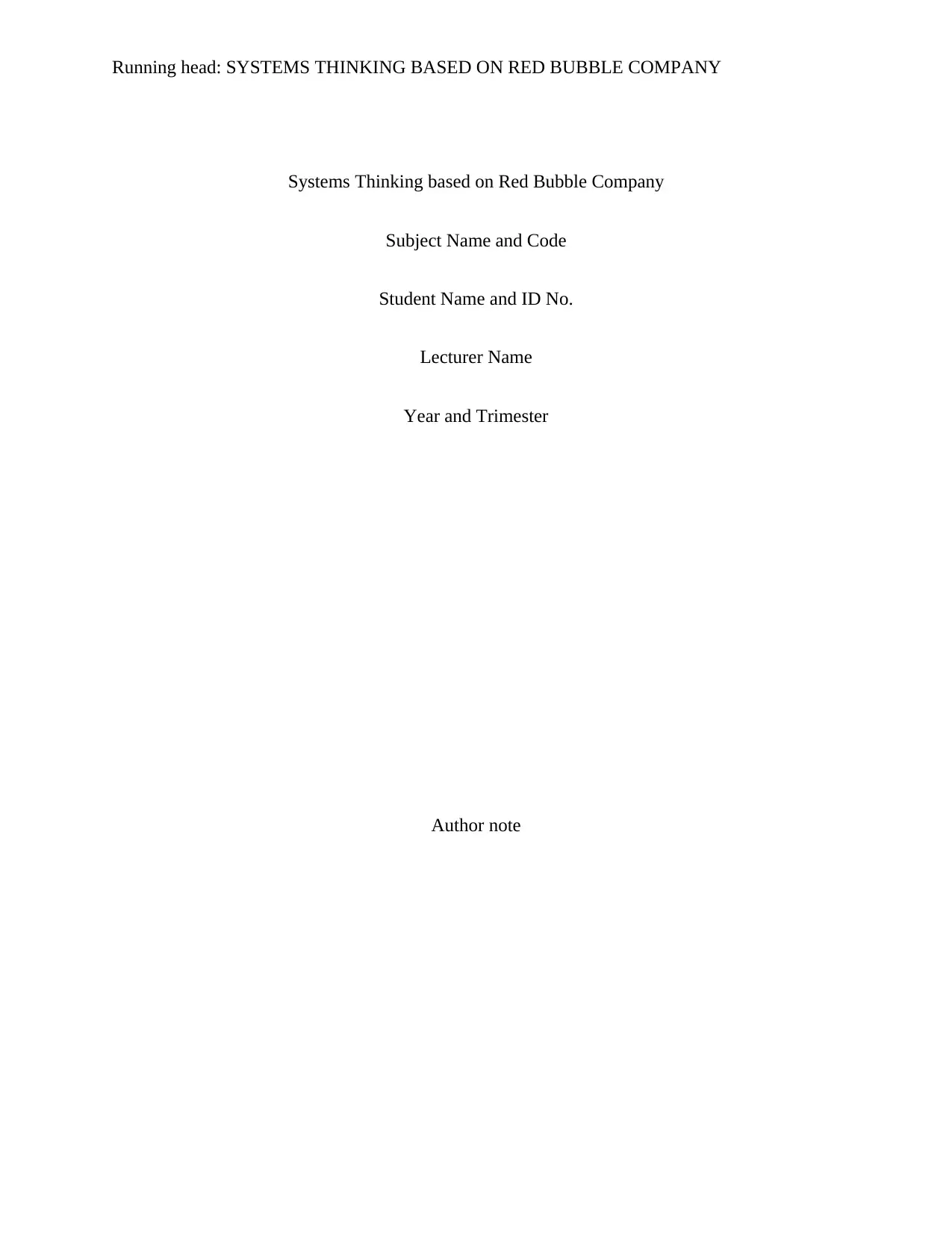
Running head: SYSTEMS THINKING BASED ON RED BUBBLE COMPANY
Systems Thinking based on Red Bubble Company
Subject Name and Code
Student Name and ID No.
Lecturer Name
Year and Trimester
Author note
Systems Thinking based on Red Bubble Company
Subject Name and Code
Student Name and ID No.
Lecturer Name
Year and Trimester
Author note
Paraphrase This Document
Need a fresh take? Get an instant paraphrase of this document with our AI Paraphraser
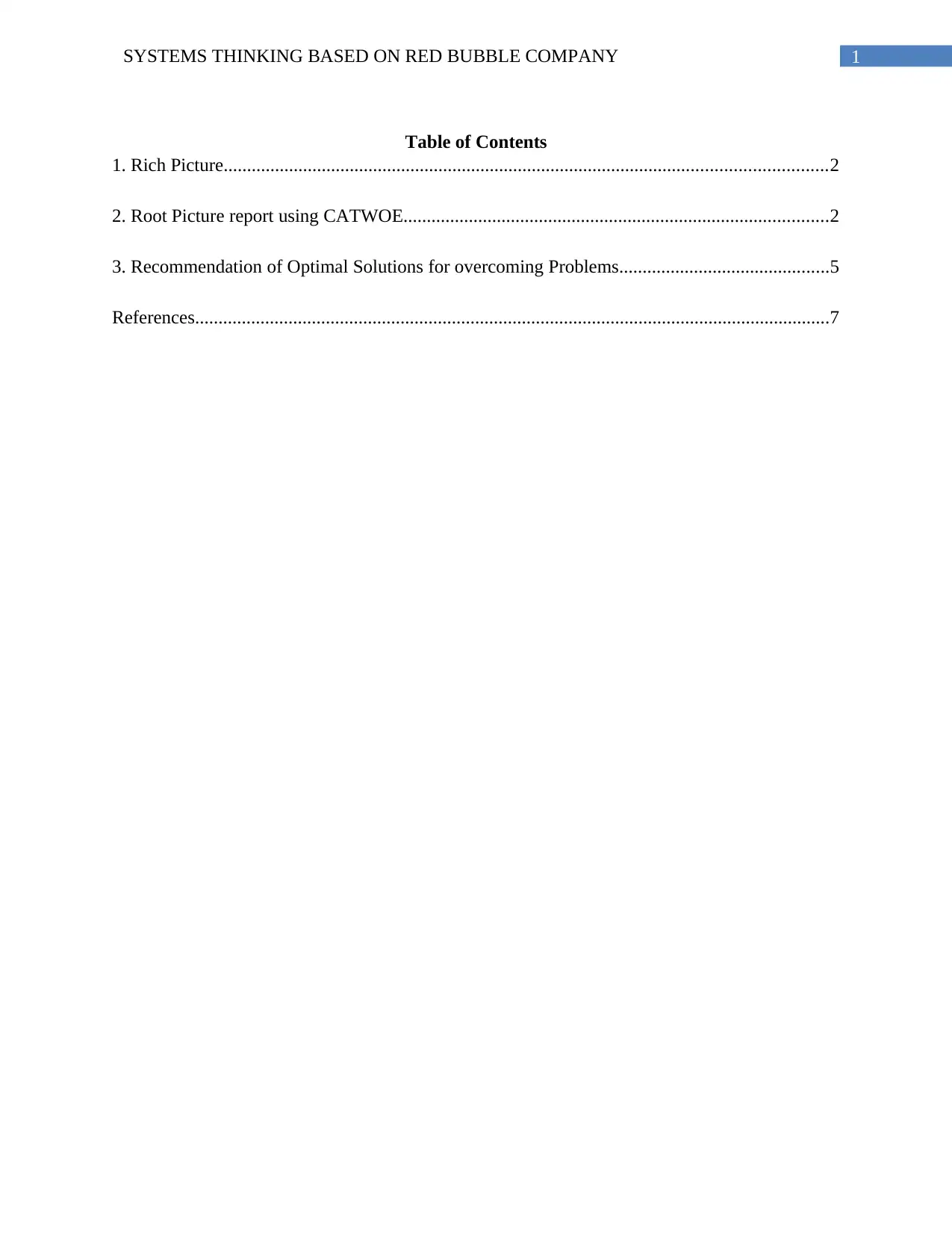
1SYSTEMS THINKING BASED ON RED BUBBLE COMPANY
Table of Contents
1. Rich Picture.................................................................................................................................2
2. Root Picture report using CATWOE...........................................................................................2
3. Recommendation of Optimal Solutions for overcoming Problems.............................................5
References........................................................................................................................................7
Table of Contents
1. Rich Picture.................................................................................................................................2
2. Root Picture report using CATWOE...........................................................................................2
3. Recommendation of Optimal Solutions for overcoming Problems.............................................5
References........................................................................................................................................7
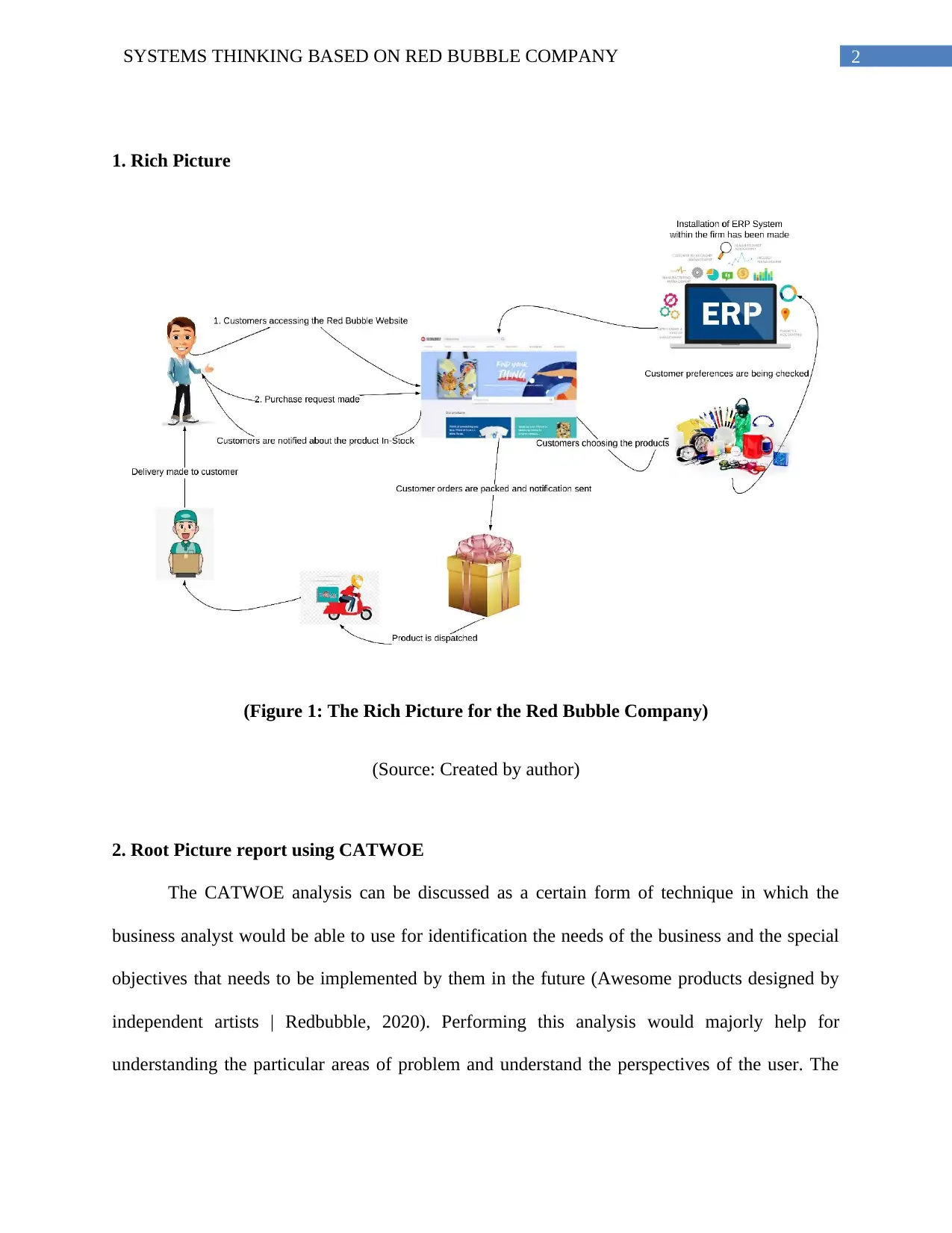
2SYSTEMS THINKING BASED ON RED BUBBLE COMPANY
1. Rich Picture
(Figure 1: The Rich Picture for the Red Bubble Company)
(Source: Created by author)
2. Root Picture report using CATWOE
The CATWOE analysis can be discussed as a certain form of technique in which the
business analyst would be able to use for identification the needs of the business and the special
objectives that needs to be implemented by them in the future (Awesome products designed by
independent artists | Redbubble, 2020). Performing this analysis would majorly help for
understanding the particular areas of problem and understand the perspectives of the user. The
1. Rich Picture
(Figure 1: The Rich Picture for the Red Bubble Company)
(Source: Created by author)
2. Root Picture report using CATWOE
The CATWOE analysis can be discussed as a certain form of technique in which the
business analyst would be able to use for identification the needs of the business and the special
objectives that needs to be implemented by them in the future (Awesome products designed by
independent artists | Redbubble, 2020). Performing this analysis would majorly help for
understanding the particular areas of problem and understand the perspectives of the user. The
⊘ This is a preview!⊘
Do you want full access?
Subscribe today to unlock all pages.

Trusted by 1+ million students worldwide
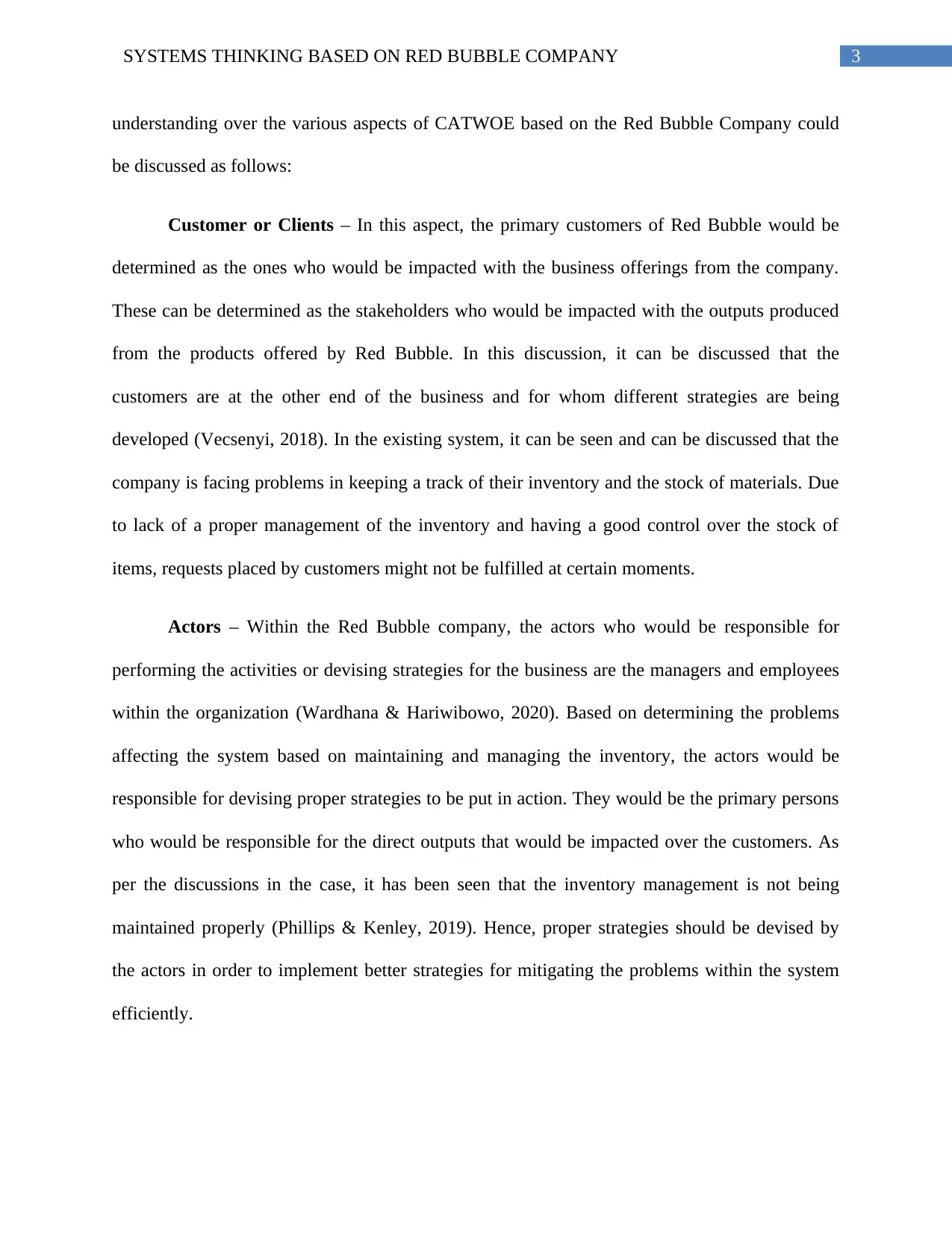
3SYSTEMS THINKING BASED ON RED BUBBLE COMPANY
understanding over the various aspects of CATWOE based on the Red Bubble Company could
be discussed as follows:
Customer or Clients – In this aspect, the primary customers of Red Bubble would be
determined as the ones who would be impacted with the business offerings from the company.
These can be determined as the stakeholders who would be impacted with the outputs produced
from the products offered by Red Bubble. In this discussion, it can be discussed that the
customers are at the other end of the business and for whom different strategies are being
developed (Vecsenyi, 2018). In the existing system, it can be seen and can be discussed that the
company is facing problems in keeping a track of their inventory and the stock of materials. Due
to lack of a proper management of the inventory and having a good control over the stock of
items, requests placed by customers might not be fulfilled at certain moments.
Actors – Within the Red Bubble company, the actors who would be responsible for
performing the activities or devising strategies for the business are the managers and employees
within the organization (Wardhana & Hariwibowo, 2020). Based on determining the problems
affecting the system based on maintaining and managing the inventory, the actors would be
responsible for devising proper strategies to be put in action. They would be the primary persons
who would be responsible for the direct outputs that would be impacted over the customers. As
per the discussions in the case, it has been seen that the inventory management is not being
maintained properly (Phillips & Kenley, 2019). Hence, proper strategies should be devised by
the actors in order to implement better strategies for mitigating the problems within the system
efficiently.
understanding over the various aspects of CATWOE based on the Red Bubble Company could
be discussed as follows:
Customer or Clients – In this aspect, the primary customers of Red Bubble would be
determined as the ones who would be impacted with the business offerings from the company.
These can be determined as the stakeholders who would be impacted with the outputs produced
from the products offered by Red Bubble. In this discussion, it can be discussed that the
customers are at the other end of the business and for whom different strategies are being
developed (Vecsenyi, 2018). In the existing system, it can be seen and can be discussed that the
company is facing problems in keeping a track of their inventory and the stock of materials. Due
to lack of a proper management of the inventory and having a good control over the stock of
items, requests placed by customers might not be fulfilled at certain moments.
Actors – Within the Red Bubble company, the actors who would be responsible for
performing the activities or devising strategies for the business are the managers and employees
within the organization (Wardhana & Hariwibowo, 2020). Based on determining the problems
affecting the system based on maintaining and managing the inventory, the actors would be
responsible for devising proper strategies to be put in action. They would be the primary persons
who would be responsible for the direct outputs that would be impacted over the customers. As
per the discussions in the case, it has been seen that the inventory management is not being
maintained properly (Phillips & Kenley, 2019). Hence, proper strategies should be devised by
the actors in order to implement better strategies for mitigating the problems within the system
efficiently.
Paraphrase This Document
Need a fresh take? Get an instant paraphrase of this document with our AI Paraphraser
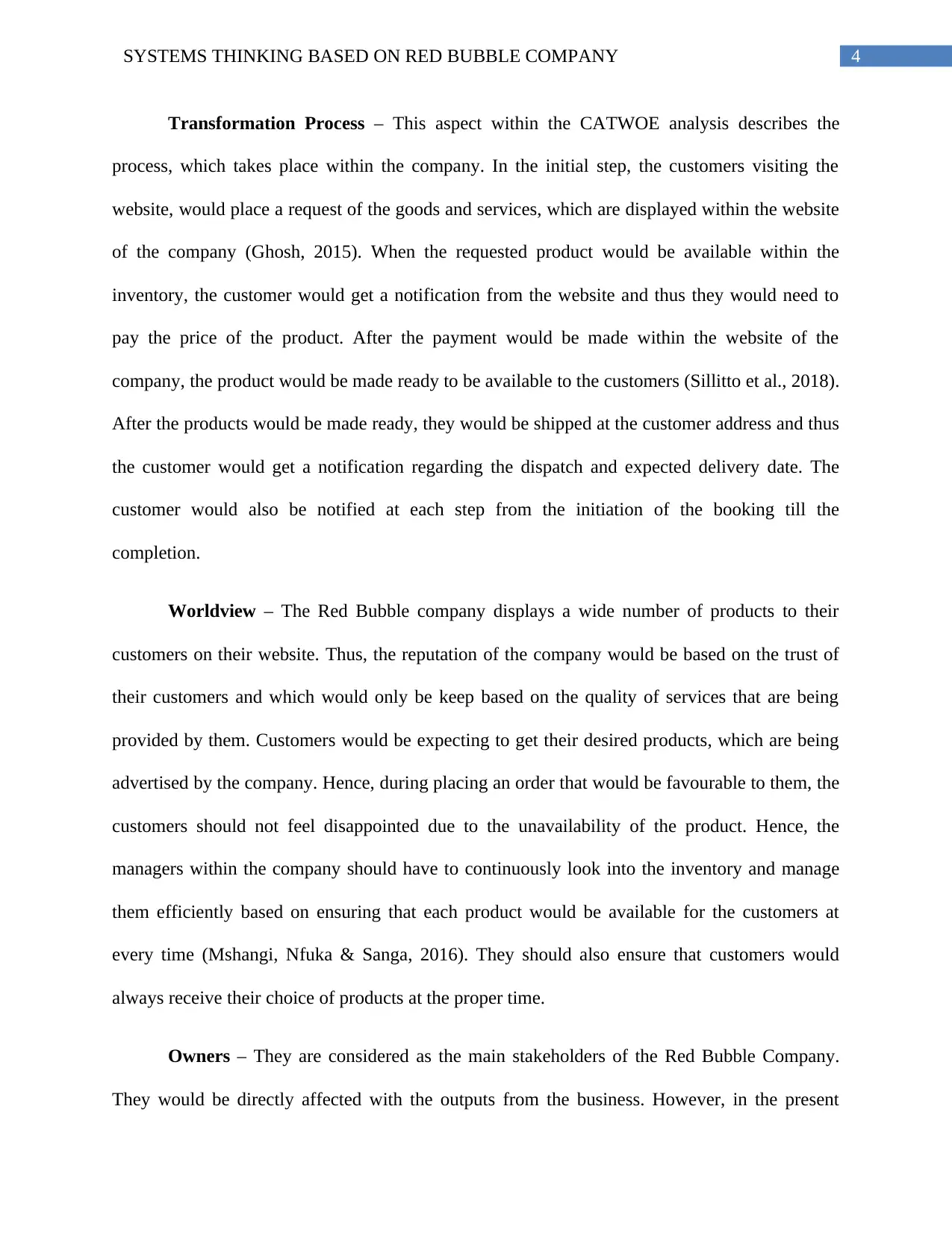
4SYSTEMS THINKING BASED ON RED BUBBLE COMPANY
Transformation Process – This aspect within the CATWOE analysis describes the
process, which takes place within the company. In the initial step, the customers visiting the
website, would place a request of the goods and services, which are displayed within the website
of the company (Ghosh, 2015). When the requested product would be available within the
inventory, the customer would get a notification from the website and thus they would need to
pay the price of the product. After the payment would be made within the website of the
company, the product would be made ready to be available to the customers (Sillitto et al., 2018).
After the products would be made ready, they would be shipped at the customer address and thus
the customer would get a notification regarding the dispatch and expected delivery date. The
customer would also be notified at each step from the initiation of the booking till the
completion.
Worldview – The Red Bubble company displays a wide number of products to their
customers on their website. Thus, the reputation of the company would be based on the trust of
their customers and which would only be keep based on the quality of services that are being
provided by them. Customers would be expecting to get their desired products, which are being
advertised by the company. Hence, during placing an order that would be favourable to them, the
customers should not feel disappointed due to the unavailability of the product. Hence, the
managers within the company should have to continuously look into the inventory and manage
them efficiently based on ensuring that each product would be available for the customers at
every time (Mshangi, Nfuka & Sanga, 2016). They should also ensure that customers would
always receive their choice of products at the proper time.
Owners – They are considered as the main stakeholders of the Red Bubble Company.
They would be directly affected with the outputs from the business. However, in the present
Transformation Process – This aspect within the CATWOE analysis describes the
process, which takes place within the company. In the initial step, the customers visiting the
website, would place a request of the goods and services, which are displayed within the website
of the company (Ghosh, 2015). When the requested product would be available within the
inventory, the customer would get a notification from the website and thus they would need to
pay the price of the product. After the payment would be made within the website of the
company, the product would be made ready to be available to the customers (Sillitto et al., 2018).
After the products would be made ready, they would be shipped at the customer address and thus
the customer would get a notification regarding the dispatch and expected delivery date. The
customer would also be notified at each step from the initiation of the booking till the
completion.
Worldview – The Red Bubble company displays a wide number of products to their
customers on their website. Thus, the reputation of the company would be based on the trust of
their customers and which would only be keep based on the quality of services that are being
provided by them. Customers would be expecting to get their desired products, which are being
advertised by the company. Hence, during placing an order that would be favourable to them, the
customers should not feel disappointed due to the unavailability of the product. Hence, the
managers within the company should have to continuously look into the inventory and manage
them efficiently based on ensuring that each product would be available for the customers at
every time (Mshangi, Nfuka & Sanga, 2016). They should also ensure that customers would
always receive their choice of products at the proper time.
Owners – They are considered as the main stakeholders of the Red Bubble Company.
They would be directly affected with the outputs from the business. However, in the present
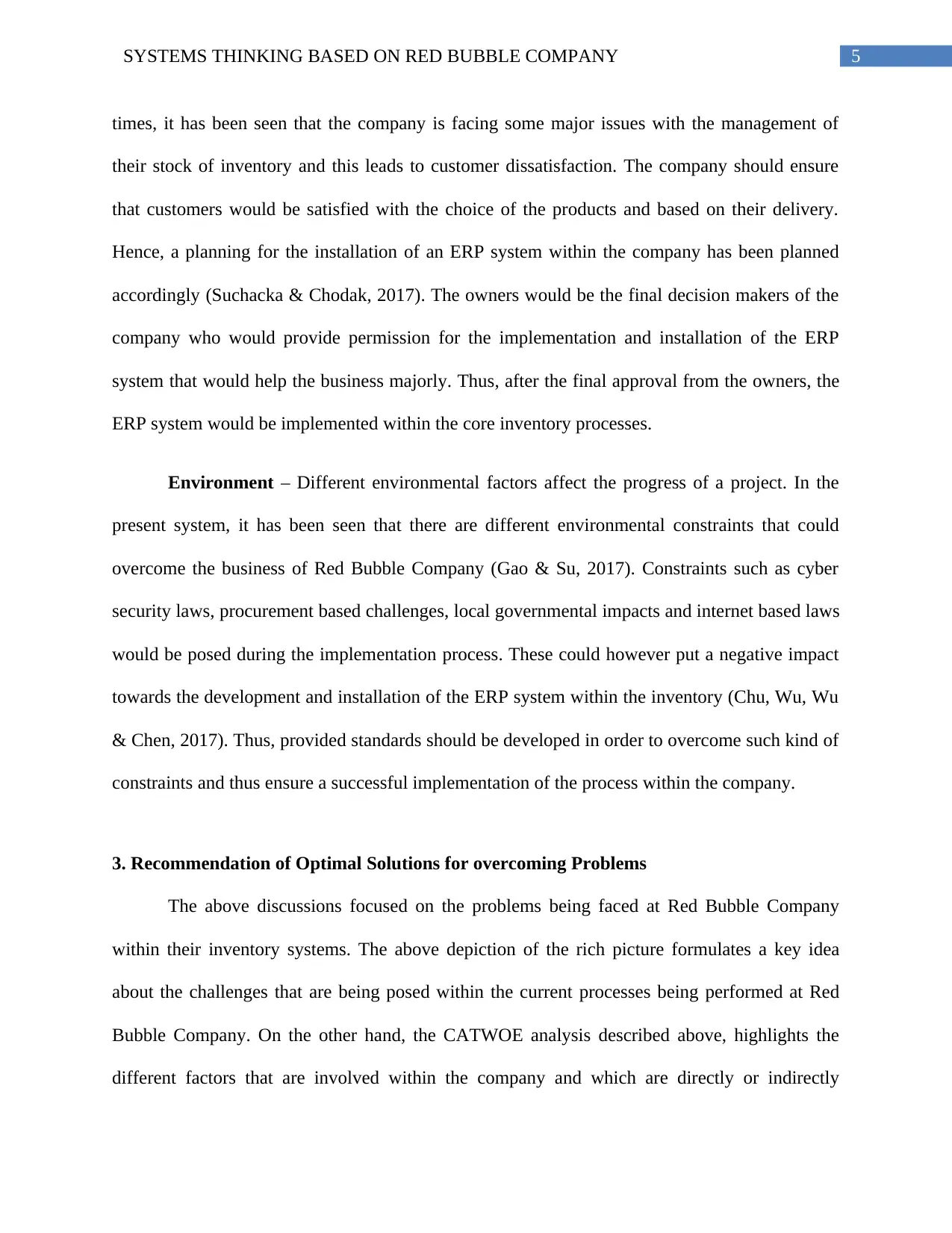
5SYSTEMS THINKING BASED ON RED BUBBLE COMPANY
times, it has been seen that the company is facing some major issues with the management of
their stock of inventory and this leads to customer dissatisfaction. The company should ensure
that customers would be satisfied with the choice of the products and based on their delivery.
Hence, a planning for the installation of an ERP system within the company has been planned
accordingly (Suchacka & Chodak, 2017). The owners would be the final decision makers of the
company who would provide permission for the implementation and installation of the ERP
system that would help the business majorly. Thus, after the final approval from the owners, the
ERP system would be implemented within the core inventory processes.
Environment – Different environmental factors affect the progress of a project. In the
present system, it has been seen that there are different environmental constraints that could
overcome the business of Red Bubble Company (Gao & Su, 2017). Constraints such as cyber
security laws, procurement based challenges, local governmental impacts and internet based laws
would be posed during the implementation process. These could however put a negative impact
towards the development and installation of the ERP system within the inventory (Chu, Wu, Wu
& Chen, 2017). Thus, provided standards should be developed in order to overcome such kind of
constraints and thus ensure a successful implementation of the process within the company.
3. Recommendation of Optimal Solutions for overcoming Problems
The above discussions focused on the problems being faced at Red Bubble Company
within their inventory systems. The above depiction of the rich picture formulates a key idea
about the challenges that are being posed within the current processes being performed at Red
Bubble Company. On the other hand, the CATWOE analysis described above, highlights the
different factors that are involved within the company and which are directly or indirectly
times, it has been seen that the company is facing some major issues with the management of
their stock of inventory and this leads to customer dissatisfaction. The company should ensure
that customers would be satisfied with the choice of the products and based on their delivery.
Hence, a planning for the installation of an ERP system within the company has been planned
accordingly (Suchacka & Chodak, 2017). The owners would be the final decision makers of the
company who would provide permission for the implementation and installation of the ERP
system that would help the business majorly. Thus, after the final approval from the owners, the
ERP system would be implemented within the core inventory processes.
Environment – Different environmental factors affect the progress of a project. In the
present system, it has been seen that there are different environmental constraints that could
overcome the business of Red Bubble Company (Gao & Su, 2017). Constraints such as cyber
security laws, procurement based challenges, local governmental impacts and internet based laws
would be posed during the implementation process. These could however put a negative impact
towards the development and installation of the ERP system within the inventory (Chu, Wu, Wu
& Chen, 2017). Thus, provided standards should be developed in order to overcome such kind of
constraints and thus ensure a successful implementation of the process within the company.
3. Recommendation of Optimal Solutions for overcoming Problems
The above discussions focused on the problems being faced at Red Bubble Company
within their inventory systems. The above depiction of the rich picture formulates a key idea
about the challenges that are being posed within the current processes being performed at Red
Bubble Company. On the other hand, the CATWOE analysis described above, highlights the
different factors that are involved within the company and which are directly or indirectly
⊘ This is a preview!⊘
Do you want full access?
Subscribe today to unlock all pages.

Trusted by 1+ million students worldwide
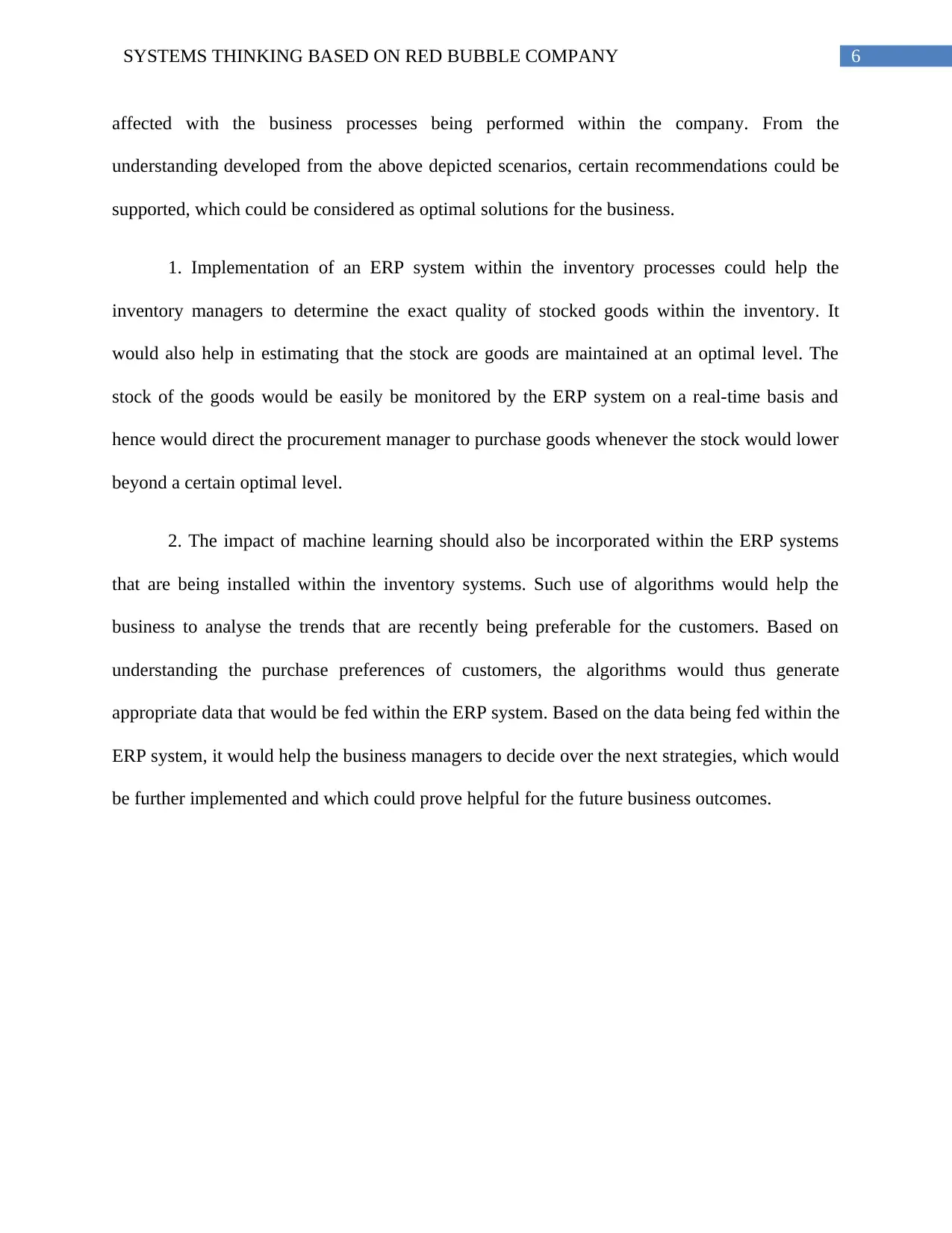
6SYSTEMS THINKING BASED ON RED BUBBLE COMPANY
affected with the business processes being performed within the company. From the
understanding developed from the above depicted scenarios, certain recommendations could be
supported, which could be considered as optimal solutions for the business.
1. Implementation of an ERP system within the inventory processes could help the
inventory managers to determine the exact quality of stocked goods within the inventory. It
would also help in estimating that the stock are goods are maintained at an optimal level. The
stock of the goods would be easily be monitored by the ERP system on a real-time basis and
hence would direct the procurement manager to purchase goods whenever the stock would lower
beyond a certain optimal level.
2. The impact of machine learning should also be incorporated within the ERP systems
that are being installed within the inventory systems. Such use of algorithms would help the
business to analyse the trends that are recently being preferable for the customers. Based on
understanding the purchase preferences of customers, the algorithms would thus generate
appropriate data that would be fed within the ERP system. Based on the data being fed within the
ERP system, it would help the business managers to decide over the next strategies, which would
be further implemented and which could prove helpful for the future business outcomes.
affected with the business processes being performed within the company. From the
understanding developed from the above depicted scenarios, certain recommendations could be
supported, which could be considered as optimal solutions for the business.
1. Implementation of an ERP system within the inventory processes could help the
inventory managers to determine the exact quality of stocked goods within the inventory. It
would also help in estimating that the stock are goods are maintained at an optimal level. The
stock of the goods would be easily be monitored by the ERP system on a real-time basis and
hence would direct the procurement manager to purchase goods whenever the stock would lower
beyond a certain optimal level.
2. The impact of machine learning should also be incorporated within the ERP systems
that are being installed within the inventory systems. Such use of algorithms would help the
business to analyse the trends that are recently being preferable for the customers. Based on
understanding the purchase preferences of customers, the algorithms would thus generate
appropriate data that would be fed within the ERP system. Based on the data being fed within the
ERP system, it would help the business managers to decide over the next strategies, which would
be further implemented and which could prove helpful for the future business outcomes.
Paraphrase This Document
Need a fresh take? Get an instant paraphrase of this document with our AI Paraphraser
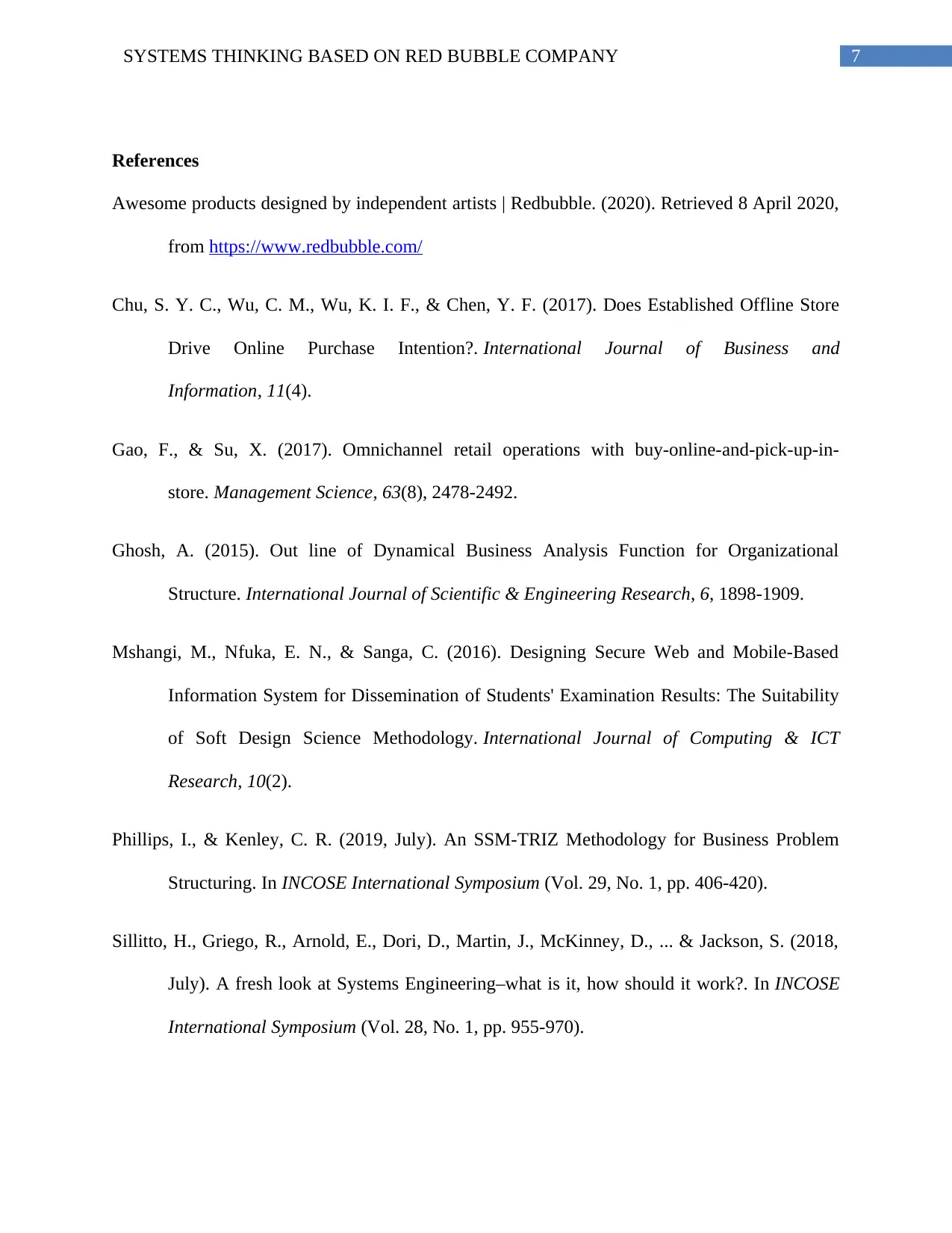
7SYSTEMS THINKING BASED ON RED BUBBLE COMPANY
References
Awesome products designed by independent artists | Redbubble. (2020). Retrieved 8 April 2020,
from https://www.redbubble.com/
Chu, S. Y. C., Wu, C. M., Wu, K. I. F., & Chen, Y. F. (2017). Does Established Offline Store
Drive Online Purchase Intention?. International Journal of Business and
Information, 11(4).
Gao, F., & Su, X. (2017). Omnichannel retail operations with buy-online-and-pick-up-in-
store. Management Science, 63(8), 2478-2492.
Ghosh, A. (2015). Out line of Dynamical Business Analysis Function for Organizational
Structure. International Journal of Scientific & Engineering Research, 6, 1898-1909.
Mshangi, M., Nfuka, E. N., & Sanga, C. (2016). Designing Secure Web and Mobile-Based
Information System for Dissemination of Students' Examination Results: The Suitability
of Soft Design Science Methodology. International Journal of Computing & ICT
Research, 10(2).
Phillips, I., & Kenley, C. R. (2019, July). An SSM‐TRIZ Methodology for Business Problem
Structuring. In INCOSE International Symposium (Vol. 29, No. 1, pp. 406-420).
Sillitto, H., Griego, R., Arnold, E., Dori, D., Martin, J., McKinney, D., ... & Jackson, S. (2018,
July). A fresh look at Systems Engineering–what is it, how should it work?. In INCOSE
International Symposium (Vol. 28, No. 1, pp. 955-970).
References
Awesome products designed by independent artists | Redbubble. (2020). Retrieved 8 April 2020,
from https://www.redbubble.com/
Chu, S. Y. C., Wu, C. M., Wu, K. I. F., & Chen, Y. F. (2017). Does Established Offline Store
Drive Online Purchase Intention?. International Journal of Business and
Information, 11(4).
Gao, F., & Su, X. (2017). Omnichannel retail operations with buy-online-and-pick-up-in-
store. Management Science, 63(8), 2478-2492.
Ghosh, A. (2015). Out line of Dynamical Business Analysis Function for Organizational
Structure. International Journal of Scientific & Engineering Research, 6, 1898-1909.
Mshangi, M., Nfuka, E. N., & Sanga, C. (2016). Designing Secure Web and Mobile-Based
Information System for Dissemination of Students' Examination Results: The Suitability
of Soft Design Science Methodology. International Journal of Computing & ICT
Research, 10(2).
Phillips, I., & Kenley, C. R. (2019, July). An SSM‐TRIZ Methodology for Business Problem
Structuring. In INCOSE International Symposium (Vol. 29, No. 1, pp. 406-420).
Sillitto, H., Griego, R., Arnold, E., Dori, D., Martin, J., McKinney, D., ... & Jackson, S. (2018,
July). A fresh look at Systems Engineering–what is it, how should it work?. In INCOSE
International Symposium (Vol. 28, No. 1, pp. 955-970).
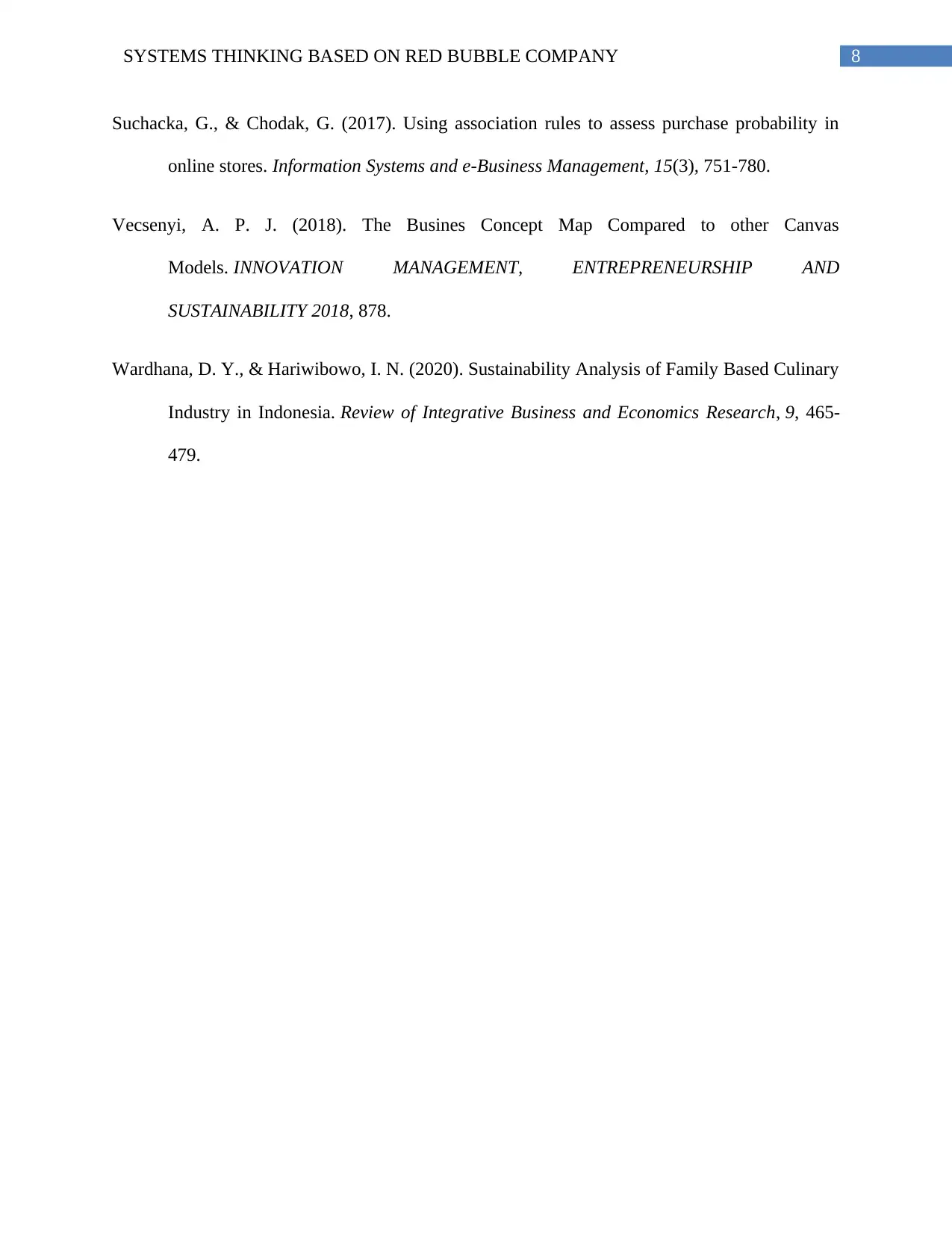
8SYSTEMS THINKING BASED ON RED BUBBLE COMPANY
Suchacka, G., & Chodak, G. (2017). Using association rules to assess purchase probability in
online stores. Information Systems and e-Business Management, 15(3), 751-780.
Vecsenyi, A. P. J. (2018). The Busines Concept Map Compared to other Canvas
Models. INNOVATION MANAGEMENT, ENTREPRENEURSHIP AND
SUSTAINABILITY 2018, 878.
Wardhana, D. Y., & Hariwibowo, I. N. (2020). Sustainability Analysis of Family Based Culinary
Industry in Indonesia. Review of Integrative Business and Economics Research, 9, 465-
479.
Suchacka, G., & Chodak, G. (2017). Using association rules to assess purchase probability in
online stores. Information Systems and e-Business Management, 15(3), 751-780.
Vecsenyi, A. P. J. (2018). The Busines Concept Map Compared to other Canvas
Models. INNOVATION MANAGEMENT, ENTREPRENEURSHIP AND
SUSTAINABILITY 2018, 878.
Wardhana, D. Y., & Hariwibowo, I. N. (2020). Sustainability Analysis of Family Based Culinary
Industry in Indonesia. Review of Integrative Business and Economics Research, 9, 465-
479.
⊘ This is a preview!⊘
Do you want full access?
Subscribe today to unlock all pages.

Trusted by 1+ million students worldwide
1 out of 9
Related Documents
Your All-in-One AI-Powered Toolkit for Academic Success.
+13062052269
info@desklib.com
Available 24*7 on WhatsApp / Email
![[object Object]](/_next/static/media/star-bottom.7253800d.svg)
Unlock your academic potential
Copyright © 2020–2025 A2Z Services. All Rights Reserved. Developed and managed by ZUCOL.





